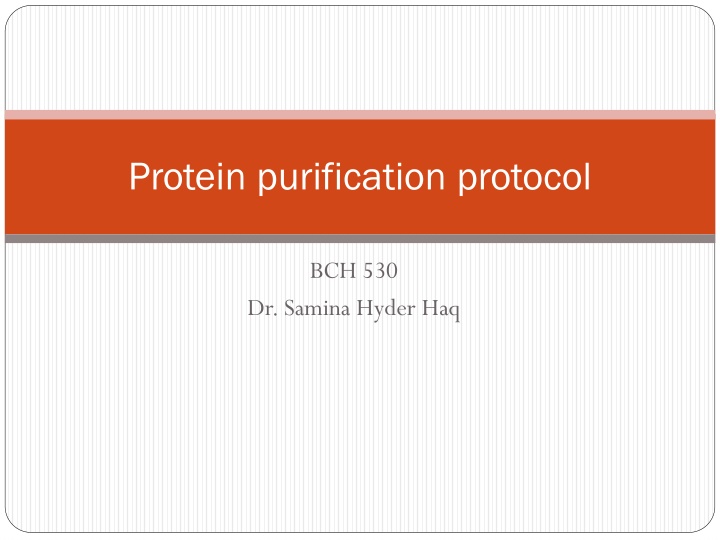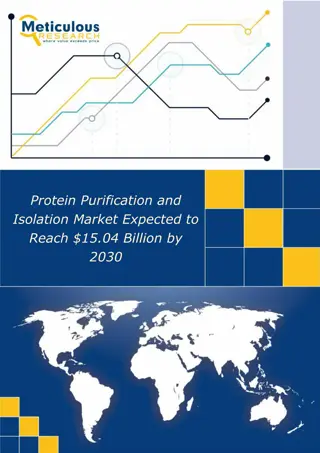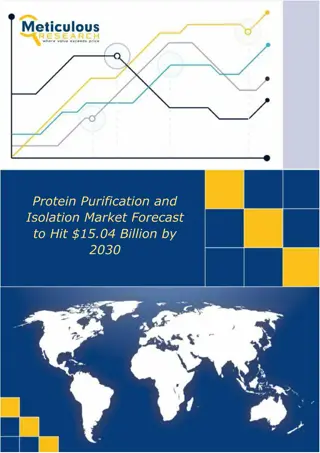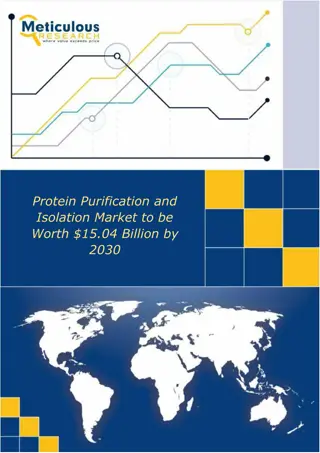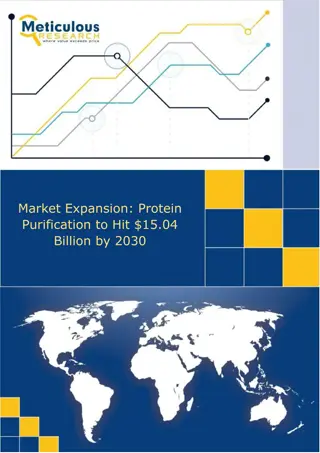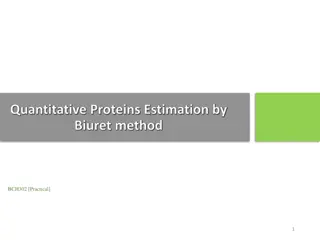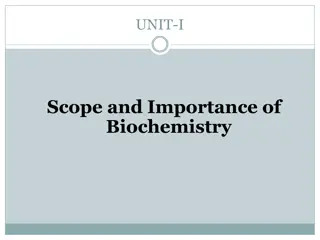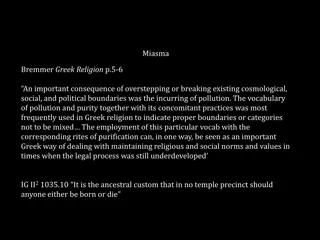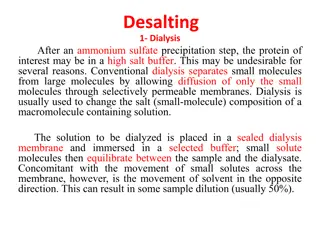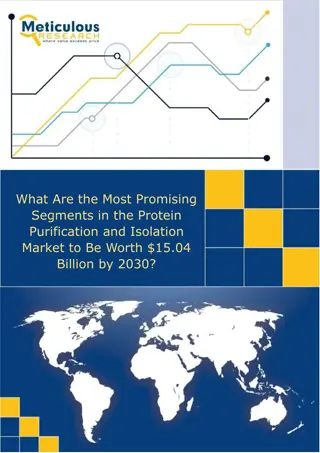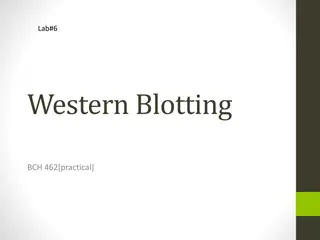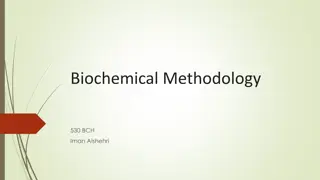Protein Purification Protocol: Practical Training in Biochemistry Techniques
This protein purification protocol course, led by Dr. Samina Hyder Haq, focuses on practical training in various biochemistry techniques. The course covers organizing experimental protocols, protein isolation strategies, sequential enzyme purification, enzyme kinetics, and writing scientific reports. Learn about purifying proteins efficiently, maintaining enzyme activity, and determining molecular weight. Follow the general protocol, starting with tissue homogenization to final purification via chromatography. Determine total protein and enzyme amounts using protein assays, such as the Lowry method.
Download Presentation

Please find below an Image/Link to download the presentation.
The content on the website is provided AS IS for your information and personal use only. It may not be sold, licensed, or shared on other websites without obtaining consent from the author.If you encounter any issues during the download, it is possible that the publisher has removed the file from their server.
You are allowed to download the files provided on this website for personal or commercial use, subject to the condition that they are used lawfully. All files are the property of their respective owners.
The content on the website is provided AS IS for your information and personal use only. It may not be sold, licensed, or shared on other websites without obtaining consent from the author.
E N D
Presentation Transcript
Protein purification protocol BCH 530 Dr. Samina Hyder Haq
objective of this course To give practical training in various Biochemistry techniques Explain how to organise experimental protocol. Learn about Protein isolation strategies. Learn about sequential purification of enzyme and evaluation of their results in the form of a table. To know about the basic enzyme kinetics . Learn about writing a Scientific report.
Purification protocol for Protein Prerequisite information about the protein. Protein are diverse in composition structure behaviour, you should know about their origin. As your purification strategy depends on it. 1. Where is this enzyme or protein present in the cell?(intracellular, extracellular, membranous). 2. How you can purify this protein in as few steps as possible without the loss of activity.(assayable enzyme activity). Keeping in consideration of temperature and time.
General protocol for protein purification Taking the intact Tissue. Homogenisation Getting rid of debris and insoluble stuff Precipitation of protein with the salt( salt in) Getting rid of salt by dialysis(salting out) Further purification by column and ion exchange chromatography , Each above step is followed by enzyme Assay activity(in case you lost your enzyme ) Finding out the exact molecular weight by Column chromatography and by SDS-Gel-electrophoresis
1stStep Homogenisation Disrupt the Tissue or cells with the help of Homogeniser.(mechanical way). To get a homogeneous solution after getting rid of cell debris, tissues and insoluble stuff either by filtering through muslin cloth or filter paper. This is your Crude extract containing the protein or enzyme of your interest plus a mixture of other proteins. Find out the amount of total protein(By Protein assay) as well as amount of your enzyme( by enzyme assay) in this Crude extract
Protein Assay Two methods 1. Lowry method as being the most accurate and sensitive method down to 0.01mg/mL and widely used . Based on the biuret reaction in which the peptide bonds of the proteins react with copper under alkaline conditions to produce CU+,which reacts with the Follins reagent resulting in strong blue colour which depends partly on aromatic a.acid such as tyrosine and tryptophane.
Protein assay by Bradford Assay This technique is simpler , faster and more accurate than lowry s method. The bradford assay relies on the binding of the dye coomasive Blue G-250 to protein.The quantity of protein can be estimated by determining the amount of dye in the blue ionic form. This is achieed by measuring the absorbance at 595nm.The dye appears to bind readly to arginyl and lysyl residues of proteins.
Preparing the standard curve for the protein Absorbance X Concentration of Protein mg/mL
Measuring enzyme activity (enzyme Assay) Depends upon the enzyme and substrate activity. Many different protocol but we are going to use spectrophotometric method. We measure the rate of reaction which is directly proportional to the amount of product formed. You should know how to calculate enzyme units and concentration of enzyme using Lambert-Beer s Law which states that the absorbance of the light absorbing material is proportional to its concentration in solution.
Enzyme assay for Acid phosphatase We will measure the relative amount of product formed by comparing the intensity of the yellow color in each tube following the reaction.
Enzyme assay for alpha amylase Alpha Amylase's official name is 1,4-a-D-Glucan glucanohydrolase; EC 3.2.1.1 It breaks the starch to maltose Assay method is that of Bernfield (1951) wherein the reducing groups released from starch are measured by the reduction of 3,5- dinitrosalicylic acid. One unit releases from soluble starch one micromole of reducing groups (calculated as maltose) per minute at 25 C and pH 6.9 under the specified conditions
Monitoring the progress of purification Protocol Total protein mg/mL Quantity of protein present in the fraction Total activity (units of activity) Use a portion of sample to determine activity. Multiply activity by total volume to determine total activity.
Specific activity (units of activity/mg) S.A =Total activity of E Total protein % yield: measure of activity retained after each step in procedure. Percentage yield = Total activity at particular step Total activity of initial extract Purification level increases at each step of purification. = S.A at particular step S.A of initial crude extract
The purification table We fill out this important table at each stage Steps Total protein Total E activit y Specific Activity Yield % Purification level 1. Crude Extract 2. Ammonium sulphate ppt 3. After Dialysis 4. Coulumn chromatography 5. Ion exchange chromatography
Ammonium sulphate(NH4)2SO4 precipitation Has a wide range of application Very effective to ppt out water soluble proteins. These ions have stabilizing effect on protein You can do sequential ppt of your desired protein depending upon its molecular weight. Proteins are readly stored as ammonium sulphate ppt.
Ammonium sulphate ppt ( a strategy) Proteins are soluble in aqueous media because they have hydrophilic amino acid side-chains facing outwards that can interact with water. These are provided by the basic amino acids (arginine, histidine, arginine and lysine), the acidic amino acids (aspartate and glutamate) and the neutral hydrophilic amino acids (asparagine, glutamine, serine, threonine, tyrosine and cysteine). Any compound that interferes with these interactions between amino acid side-chains and water, by reducing the available water, will reduce the solubility of the protein. As interactions with water become less marked, so protein-protein interactions become more important, and the protein will aggregate and come out of solution. Provided that the temperature is maintained low enough (around 4C), the protein is not irreversibly denatured, but the precipitate can be redissolved in buffer.
Salting in Most native soluble proteins like globular proteins are soluble at 25% ammonium sulphate but ppt out at 100% Try to choose the saturation where the desired protein is soluble but others ppt out Can salt out the unwanted proteins for example at 25% saturation and than increase the salt concentration to ppt out the desired proteins.
Salting in Salting IN At low concentrations, added salt usually increases the solubility of charged macromolecules because the salt screens out charge-charge interactions. So low [salt] prevents aggregation and therefore precipitation or crashing.
Salting in At high concentrations added salt lowers the solubility of macromolecules because it competes for the solvent (H2O) needed to solvate the macromolecules. So high [salt] removes the solvation sphere from the protein molecules and they come out of solution
Salt OUT Dialysis is commonly used for removing the salt from the proteins. As ammonium sulphate presence in the protein can interfere in many ways.
Dialysis Passage of solutes through a semi-permeable membrane. Pores in the dialysis membrane are of a certain size. Protein stays in; water, salts, protein fragments, and other molecules smaller than the pore size pass through it.
Dialysis will increase the volume of the enzyme solution, because of the initial osmotic effect of the ammonium sulphate; (this is why it is important to leave an air gap at the top of the membrane tube, to prevent it bursting).
Overview of the Protein purification protocol Crude extract Protein assay Enzyme assay Sequential (0-30% or 30-80%)Ammonium sulphate precipitation Protein assay Enzyme assay Dialysis Protein assay Enzyme Assay
You Must!!! Not through away any sample unless you are sure you don't need it Label everything clearly. Keep the enzyme solution and buffers on ice. Be efficient don't waste time between two steps. Always plan before . Record all the readings and protocol steps on a proper note book instead of using scrape paper and losing it. Be organised and methodical. Keep your workplace clean and tidy , avoid using someone else workplace and be confused.
